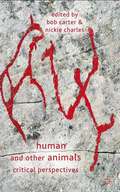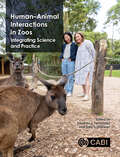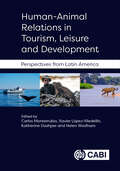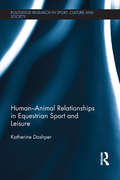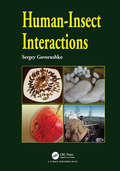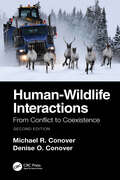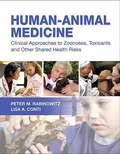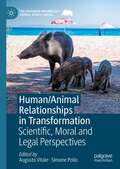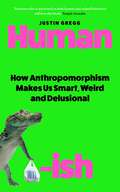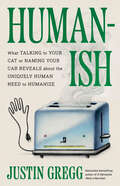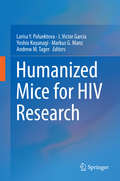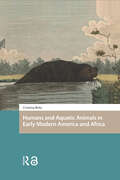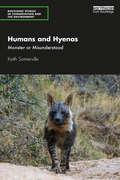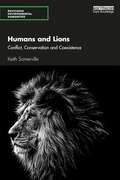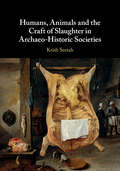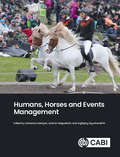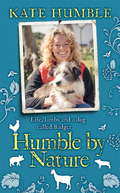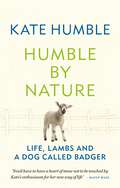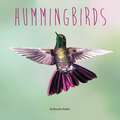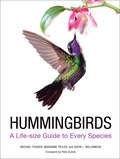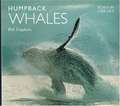- Table View
- List View
Human and Other Animals
by Bob CarterThis collection brings together a range of inter-disciplinary works which explore the questions raised by scientific practices and by different ways of conceptualizing the place of human beings in the material world. The contributors consider theoretical issues and the debate between those who advocate a post-humanist abandonment of any distinction between society and nature, human and animal, and those who argue for the importance of retaining these categorical distinctions. Through a range of case studies, they explore practices which reproduce and/or challenge the species barrier, including issues of animal rights and animal welfare, whether and under what circumstances animals are regarded as social actors with agency, media representations of human-animal relations, and the relation between animals and national identity. Taken together, these essays examine the social and political ramifications of different ways of theorizing and researching the relation between human and other animals.
Human-Animal Interactions in Zoos: Integrating Science and Practice
by Terry L. Maple Courtney Collins Amanda D. Webber Ellen Williams Geoff Hosey Vicky Melfi Sarah Webber Samantha J. Chiew Jon Coe Neil D’Cruze Angela J Dean Polly Doodson Lucy Dumbell Ashley N. Edes Kelly S Fielding Georgina Groves Lauren M. Hemsworth Paul H. Hemsworth Julia Hoy Violet Hunton Mark J. Learmonth Emily M McLeod Georgia Oaten Chris Pawson Bonnie M. Perdue David M. Powell Samantha WardHuman-Animal Interactions (HAI) are a primary welfare interest to both animal scientists and practitioners. In zoos and aquariums, the study of Animal-Visitor Interactions (AVI), including both the impact of visitors on animals (the visitor effect) and the impact of animals on visitors (the visitor experience), have become a focus for understanding HAIs in zoos. The study of HAIs in zoos has grown to consider a number of factors, including animal-staff interactions and bonds, modern exhibit design and technology, direct and indirect interactions, as well as positive and negative impacts on both animals and visitor alike. This thought-provoking book summarizes the latest research concerning the impacts of HAIs in zoos, including considerations for conducting research and managing HAIs. The book: Explores the interactions of animals with keepers, veterinary professionals, and other staff, and the effects of those interactions on the welfare of animals. Considers the impact of visitors on the well-being of animals. Covers the effects of interactions on education and the visitor experience. Outlines the use of technology to enhance experience, and improve animal welfare. Details theoretical, ethical, and practical considerations relevant to HAIs in zoos. An invaluable resource for animal behaviour and welfare scientists, students and practitioners, as well as anyone working with zoo animals.
Human-Animal Relations in Tourism, Leisure and Development: Perspectives from Latin America
by Katherine Dashper Carlos Monterrubio Xavier López-Medellín Helen WadhamHumans and animals have developed multiple and complex interactions in the fields of tourism, leisure, and development. However, much of the existing research on how humans and animals interact in these fields has emerged from within the context of developed countries. As a result, little has been documented about human-animal interactions in the socioeconomic, cultural, and environmental contexts of countries in the Global South. Specifically, the diversity and complexity of interspecies relationships in tourism, leisure, and local development in Latin America have been largely ignored in Anglo-Saxon literature. This has resulted in a limited, partial, and hegemonic understanding and debate about human-animal relationships globally, dominated by certain regions of the world. This book addresses this gap by documenting multiple and complex relationships between humans and animals in the fields of tourism, leisure, and local development in countries in Latin America. The book: Brings together empirical and conceptual works that reveal different disciplinary, theoretical, ethical, methodological, and practical perspectives. Reveals how human-animal relationships - both domestic and wild - can result in co-created interspecies experiences, conflicts, conservation efforts, welfare, and local development of human societies in the region. Equips stakeholders with conceptual frameworks and actionable tools to formulate policies that blend animal welfare and sustainability in Latin American tourism and recreation strategies. Challenges dominant narratives from the Global North regarding tourism and conservation, promoting a more inclusive and nuanced approach. This book will be of interest to researchers, professionals and policymakers within tourism, leisure, animal welfare, conservation and destination development.
Human-Animal Relationships in Equestrian Sport and Leisure (Routledge Research in Sport, Culture and Society)
by Katherine DashperRiding, training and caring for horses are visceral experiences that require the immersion of both body and mind. This book provides an in-depth understanding of human–horse relationships and interactions as embodied in equestrian sport and leisure. As a closely focused ethnographic study of the horse world, it explores the key themes of partnership and collaboration in human–horse communication, the formation of individual and collective identities performed through involvement in the horse world, and human–horse interaction as an embodied way of being. This book argues that encounters between humans and horses can reveal the ways that human society has been and continues to be structured through intersection with nonhuman others. Equestrian sport and leisure provides an apt context for considering how such concepts of interspecies communication and collaboration are negotiated, managed, (mis)understood and performed, resulting in a uniquely embodied way of knowing and being in the world. Human–Animal Relationships in Equestrian Sport and Leisure is fascinating reading for anyone interested in equestrianism, human-animal studies, theories of embodiment, the sociology of sport, or sport and social theory.
Human-Insect Interactions
by Sergey GovorushkoThis book presents a 360-degree picture of the world of insects and explores how their existence affects our lives: the "good, bad, and ugly" aspects of their interactions with humankind. It provides a lucid introductory text for beginning undergraduate students in the life sciences, particularly those pursuing beginner courses in entomology, agriculture, and botany.
Human-Wildlife Interactions: From Conflict to Coexistence
by Michael R. Conover Denise O. ConoverThis book won the 2023 The Wildlife Society Publication Award in the authored book category. Human-wildlife interactions increase exponentially as more and more humans and wildlife crowd into the same limited space. Such interactions often become conflicts when wildlife threaten human health and safety, well-being, or the food supply. This second edition of Human-Wildlife Interactions: From Conflict to Coexistence provides a comprehensive review of the severity of these problems and the methods used to resolve clashes between humans and wildlife. During his forty-year career as a wildlife professor and scientist, Dr. Michael Conover, founder of journal Human-Wildlife Interactions, has become a recognized leader of the scientific field of human-wildlife interactions. In this book, he presents the range of methods for wildlife damage management, including employing lethal methods; distributing supplemental food; changing the behavior of either humans or wildlife; and excluding or repelling wildlife. Backed by numerous case studies and informative side bars, the book documents resolutions to specific human-wildlife conflicts throughout the literature. Containing full color illustrations throughout, the second edition of Human-Wildlife Interactions: From Conflict to Coexistence provides authoritative coverage and depth of both theoretical and practical information. It serves as an invaluable resource for students, researchers, and professional wildlife managers. Disclaimer: Figure 7.7 (b) on page 251 was incorrectly attributed in previous printings. The photographer of figure 7.7 (b) is Cynthia Herrick.
Human-animal Medicine: Clinical Approaches To Zoonoses, Toxicants And Other Shared Health Risks
by Lisa Conti Peter RabinowitzHuman-Animal Medicine is an innovative reference exploring the unprecedented convergence of human, animal, and environmental health, triggering global pandemics and requiring new clinical paradigms. The "One Health" approach calls for greater communication and cooperation between human health care providers, public health professionals, and veterinarians to better address vital issues of emerging diseases and environmental change. This incredibly timely book provides, for the first time, practical guidelines for "One Health" collaborations in a wide range of clinical human-animal health issues, including the H1N1 virus, zoonotic diseases, the human-animal bond, animal allergy, bites and stings, and animals as "sentinels" for toxic environmental health hazards.
Human/Animal Relationships in Transformation: Scientific, Moral and Legal Perspectives (The Palgrave Macmillan Animal Ethics Series)
by Augusto Vitale Simone PolloThe ethics of human/animal relationships is a growing field of academic research and a topic for public discussion and regulatory interventions from law-makers, governments and private institutions. Human/animal relationships are in transformation and understanding the nature of this process is crucial for all those who believe that the enlargement of moral and legal recognition to nonhuman animals is part of contemporary moral and political progress. Understanding the nature of this process means analysing and critically discussing the philosophical, scientific and legal concepts and arguments embedded in it. This book contributes to the discussion by bringing together the ideas and reflections of leading experts from different disciplinary backgrounds and with a range of scientific perspectives.This book both provides an up-to-date examination of the transformation of human/animal relationships and presents ideas to foster this process.
Humanish: How Anthropomorphism Makes Us Smart, Weird and Delusional
by Justin GreggEver glanced at your cat and wondered if they were plotting something? Or passed a car and thought it seemed &‘friendly&’, &‘surprised&’ or &‘angry&’ depending on the shape of its headlights? Anthropomorphism – the irresistible desire to apply human characteristics to animals, natural phenomena and even inanimate objects – is as natural as breathing. And it gets weirder… Million-dollar industries have sprung up to provide &‘cosmetic enhancements&’ for dogs who&’ve had the snip – their (inevitably male) owners wracked with guilt that their pets might be missing out on… something. Similarly, Justin Gregg, a researcher with the Dolphin Communication Project, regularly receives emails from mothers-to-be convinced that dolphins would make excellent midwives (spoiler alert: they definitely wouldn&’t). Diving into the strange way anthropomorphism shapes our understanding of the world, Gregg offers an eye-opening journey through human perception. From cinema&’s obsession with talking animals to the way we interact with our soon-to-be robot overlords, Humanish takes a hilarious journey through the strange world of anthropomorphism and explores what it reveals about this weird and wonderful bias within us all.
Humanish: What Talking to Your Cat or Naming Your Car Reveals About the Uniquely Human Need to Humanize
by Justin GreggA playful deep dive into anthropomorphism (our peculiar tendency to humanize the nonhuman) that will resonate with anyone who has thrown a birthday party for their dog. Bestselling science writer Justin Gregg explores the science behind our instinct to see ourselves in the creatures and objects around us. Ours is a world filled with emotional support alligators, a woman who married her briefcase, and Soviet super babies that drink dolphin milk. Delivered with a delightful mix of scientific insight and humor, Humanish is a groundbreaking exploration of one of the most powerful—but rarely talked about—cognitive biases influencing our behavior. Through quirky stories and fascinating research, Gregg unravels the reasons behind why we treat our pets like babies, fall in love with chatbots, and talk to our cars. Discover how anthropomorphism drives both consumerism and the coming AI revolution, and how the inverse process, dehumanization, allows us to treat our fellow humans so inhumanely. Explore the brighter side of anthropomorphism&’s biological benefits—it helps us connect with other humans and make sense of our unpredictable world. Humanish is filled with captivating stories and invaluable ideas of how we can harness our understanding of anthropomorphism to build healthier relationships and enrich our lives
Humanized Mice for HIV Research
by Larisa Y. Poluektova J. Victor Garcia Yoshio Koyanagi Markus G. Manz Andrew M. TagerOver the last several years the field of humanized mice has matured and developed into an essential component of translational research for HIV/AIDS. Humanized mice serve both as vehicles for discovery and as highly sophisticated platforms for biomedical research. In addition, humanized mice have demonstrated outstanding potential for the investigation of critical aspects of the infection and pathogenesis of the hepatitis and herpes viruses, as well as highly relevant microbial infections such as tuberculosis and malaria. Humanized Mice for HIV Research provides a comprehensive presentation of the history, evolution, applications, and current state of the art of this unique animal model. An expansion of twelve review articles that were published in Humanized Mice by Springer in 2008 (Eds: Nomura T, Watanabe T, Habu S), this book expertly captures the outstanding progress that has been made in the development, improvement, implementation, and validation of humanized mouse models. The first two parts of this book cover the basics of human-to-mouse xenotransplantation biology, and provide critical information about human immune cell development and function based on individual models created from different immunodeficient strains of mice. The third and fourth parts investigate HIV-1 biology, including different routes of transmission, prevention, treatment, pathogenesis, and the development of adaptive immunity in humanized mice. The fifth part shows the broad applicability of humanized mice for therapeutic development, from long-acting antiretroviral combinations to genetic manipulations with human cells and cell-based approaches. The sixth part includes liver tissue engineering and the expansion of humanized mice for many other human cell-tropic pathogens.
Humans and Aquatic Animals in Early Modern America and Africa (Environmental Humanities in Pre-modern Cultures)
by Cristina BritoThis book deals with peoples’ practices, perceptions, emotions and feelings towards aquatic animals, their ecosystems and nature on the early modern Atlantic coasts by addressing exploitation, use, fear, empathy, otherness, and indifference in the relationships established with aquatic environments and resources by Indigenous Peoples and Europeans. It focuses on large aquatic fauna, especially manatees (but also sharks, sea turtles, seals, and others) as they were hunted, consumed, venerated, conceptualised, and recorded by different societies across the early colonial Americas and West Africa. Through a cross-cultural approach drawing on concepts and analytical methods from marine environmental history, the blue humanities and animal studies, this book addresses more-than-human systems where ecologies, geographies, cosmogonies, and cultures are an entangled web of interdependencies.
Humans and Hyenas: Monster or Misunderstood (Routledge Studies in Conservation and the Environment)
by Keith SomervilleHumans and Hyenas examines the origins and development of the relationship between the two to present an accurate and realistic picture of the hyena and its interactions with people. The hyena is one of the most maligned, misrepresented and defamed mammals. It is still, despite decades of research-led knowledge, seen as a skulking, cowardly scavenger rather than a successful hunter with complex family and communal systems. Hyenas are portrayed as sex-shifting deviants, grave robbers and attackers of children in everything from African folk tales through Greek and Roman accounts of animal life, to Disney’s The Lion King depicting hyenas with a lack of respect and disgust, despite the reality of their behaviour and social structures. Combining the personal, in-depth mining of scientific papers about the three main species and historical accounts, Keith Somerville delves into our relationship with hyenas from the earliest records from millennia ago, through the accounts by colonisers, to contemporary coexistence, where hyenas and humans are forced into ever closer proximity due to shrinking habitats and loss of prey. Are hyenas fated to retain their bad image or can their amazing ability to adapt to humans more successfully than lions and other predators lead to a shift in perspective? This book will be of great interest to students and scholars in the environmental sciences, conservation biology, and wildlife and conservation issues.
Humans and Lions: Conflict, Conservation and Coexistence (Routledge Environmental Humanities)
by Keith SomervilleThis book places lion conservation and the relationship between people and lions both in historical context and in the context of the contemporary politics of conservation in Africa. The killing of Cecil the Lion in July 2015 brought such issues to the public’s attention. Were lions threatened in the wild and what was the best form of conservation? How best can lions be saved from extinction in the wild in Africa amid rural poverty, precarious livelihoods for local communities and an expanding human population? This book traces man’s relationship with lions through history, from hominids, to the Romans, through colonial occupation and independence, to the present day. It concludes with an examination of the current crisis of conservation and the conflict between Western animal welfare concepts and sustainable development, thrown into sharp focus by the killing of Cecil the lion. Through this historical account, Keith Somerville provides a coherent, evidence-based assessment of current human-lion relations, providing context to the present situation. This book will be of interest to students and scholars of environmental and African history, wildlife conservation, environmental management and political ecology, as well as the general reader.
Humans, Animals, and the Craft of Slaughter in Archaeo-Historic Societies
by Krish SeetahIn this book, Krish Seetah uses butchery as a point of departure for exploring the changing historical relationships between animal utility, symbolism, and meat consumption. Seetah brings together several bodies of literature - on meat, cut marks, craftspeople, and the role of craft in production - that have heretofore been considered in isolation from one another. Focusing on the activity inherent in butcher, he describes the history of knowledge that typifies the craft. He also provides anthropological and archaeological case studies which showcase examples of butchery practices in varied contexts that are seldom identified with zooarchaeological research. Situating the relationship between practice, practitioner, material and commodity, this imaginative study offers new insights into food production, consumption, and the craft of cuisine.
Humans, Horses and Events Management
by Katherine Dashper Guðrún Helgadóttir Ingibjörg SigurðardóttirHorses are perhaps the most common non-human animal to feature in planned events, but although there is considerable research on equestrian sport, there is virtually none on equestrian events. This book begins to address this gap, using the National Championships of the Icelandic Horse as an extended case study to explain in depth the process of managing an event, as well as the larger theoretical implications of events management. Drawing on diverse viewpoints and theoretical perspectives, the book draws wider comparisons to connect events management to larger themes in the social sciences, such as human-animal relations; nationalism; place branding; event impacts; event experience; and inclusion and exclusion. The book is a contribution to two fields. In relation to human-animal studies, it focuses on how the Icelandic horse breed is marketed and celebrated through top-tier competition; whereas from an events management perspective, it considers the role of the event in community building, the practical and theoretical aspects of running a sustainable equestrian event, and the issues that arise in multispecies event contexts. This book: - Uniquely draws together events management and human-animal studies. - Is formed from empirical research conducted by a multinational team of events management and tourism researchers. - Uses a single, extended case study to explore a range of themes and issues, both empirically and theoretically. A valuable resource for researchers of events management, human-animal studies and tourism, this book also provides an in-depth look at end-to-end events management for industry professionals.
Humble by Nature
by Kate HumbleIn 2007, after twenty years of living in London, Kate Humble and her husband Ludo decided it was time to leave city life behind them. Three years later, now the owner of a Welsh smallholding, Kate hears that a nearby farm is to be broken up and sold off. Another farm lost; another opportunity for a young farmless farmer gone. Desperate to stop the sale, Kate contacts the council with an alternative plan - to keep the farm working and to run a rural skills and animal husbandry school alongside it. Against all odds, she succeeds.Here, in Humble By Nature, Kate shares with us a highly personal account of her journey from London town house to Welsh farm. Along the way we meet Bertie and Lawrence the donkeys, Myfanwy and Blackberry the pigs and goats Biscuit and Honey, not forgetting a dog called Badger and his unladylike sidekick Bella. And we are introduced to the tenant farmers Tim and Sarah, the locals who helped and some who didn't, and a whole host of newborn lambs. Full of the warmth and passion for the natural world that makes Kate such a sought after presenter, Humble By Nature is the story of two people prepared to follow their hearts and save a small part of Britain's farming heritage, whatever the consequences.
Humble by Nature: Life, lambs and a dog called Badger
by Kate Humble'You'd have to have a heart of stone not to be touched by Kate's enthusiasm for her new way of life' - Daily MailIn 2007, after 20 years of living in London, Kate Humble and her husband Ludo decided it was time to leave city life behind them. Three years later, now the owner of a Welsh smallholding, Kate hears that a nearby farm is to be broken up and sold off. Another farm lost; another opportunity for a young farmless farmer gone. Desperate to stop the sale, Kate contacts the council with an alternative plan - to keep the farm working and to run a rural skills and animal husbandry school alongside it. Against all odds, she succeeds.Here, in Humble by Nature, Kate shares with us a highly personal account of her journey from London town house to Welsh farm. Along the way we meet Bertie and Lawrence the donkeys, Myfanwy and Blackberry the pigs and goats Biscuit and Honey, not forgetting a dog called Badger and his unladylike sidekick Bella. And we are introduced to the tenant farmers Tim and Sarah, the locals who helped and some who didn't, and a whole host of newborn lambs.Full of the warmth and passion for the natural world that makes Kate such a sought after presenter, Humble By Nature is the story of two people prepared to follow their hearts and save a small part of Britain's farming heritage, whatever the consequences.
Humble by Nature: Life, lambs and a dog called Badger (Kate Humble)
by Kate Humble'You'd have to have a heart of stone not to be touched by Kate's enthusiasm for her new way of life' - Daily MailIn 2007, after 20 years of living in London, Kate Humble and her husband Ludo decided it was time to leave city life behind them. Three years later, now the owner of a Welsh smallholding, Kate hears that a nearby farm is to be broken up and sold off. Another farm lost; another opportunity for a young farmless farmer gone. Desperate to stop the sale, Kate contacts the council with an alternative plan - to keep the farm working and to run a rural skills and animal husbandry school alongside it. Against all odds, she succeeds.Here, in Humble by Nature, Kate shares with us a highly personal account of her journey from London town house to Welsh farm. Along the way we meet Bertie and Lawrence the donkeys, Myfanwy and Blackberry the pigs and goats Biscuit and Honey, not forgetting a dog called Badger and his unladylike sidekick Bella. And we are introduced to the tenant farmers Tim and Sarah, the locals who helped and some who didn't, and a whole host of newborn lambs.Full of the warmth and passion for the natural world that makes Kate such a sought after presenter, Humble By Nature is the story of two people prepared to follow their hearts and save a small part of Britain's farming heritage, whatever the consequences.
Humble by Nature: Life, lambs and a dog called Badger (Kate Humble)
by Kate Humble'You'd have to have a heart of stone not to be touched by Kate's enthusiasm for her new way of life' - Daily MailIn 2007, after 20 years of living in London, Kate Humble and her husband Ludo decided it was time to leave city life behind them. Three years later, now the owner of a Welsh smallholding, Kate hears that a nearby farm is to be broken up and sold off. Another farm lost; another opportunity for a young farmless farmer gone. Desperate to stop the sale, Kate contacts the council with an alternative plan - to keep the farm working and to run a rural skills and animal husbandry school alongside it. Against all odds, she succeeds.Here, in Humble by Nature, Kate shares with us a highly personal account of her journey from London town house to Welsh farm. Along the way we meet Bertie and Lawrence the donkeys, Myfanwy and Blackberry the pigs and goats Biscuit and Honey, not forgetting a dog called Badger and his unladylike sidekick Bella. And we are introduced to the tenant farmers Tim and Sarah, the locals who helped and some who didn't, and a whole host of newborn lambs.Full of the warmth and passion for the natural world that makes Kate such a sought after presenter, Humble By Nature is the story of two people prepared to follow their hearts and save a small part of Britain's farming heritage, whatever the consequences.
Hummingbirds (Nature's Children)
by Jolyon GoddardHow many different kinds of hummingbirds are there? How big is a hummingbird? What do hummingbirds eat? Find the answers to these questions, and learn much more about the physical characteristics, behavior, habitat, and lives of hummingbirds.
Hummingbirds (Penguin Core Concepts Ser.)
by Bonnie BaderHummingbirds are some of the most beautiful, tiniest birds in nature. They are the only creatures that can fly forward, backward, sideways—even upside down! Their hearts beat anywhere from 500 to 1200 times every minute; their wings flap as many as 52 times per second; and they breathe up to 600 times per minute. This fact-and-photo-filled nonfiction 8x8 will leave readers astounded by the smallest bird in America!
Hummingbirds: A Life-size Guide to Every Species
by Marianne Taylor Sheri L. Williamson Michael Fogden“Packed with information . . . this book showcases species such as the Green-crowned Brilliant, the Fiery Topaz and . . . Cuban Bee Hummingbird.” —Daily MailHummingbirds have always held popular appeal, with their visual brilliance, extraordinary flight dexterity, jewel-like color, and remarkably small size.This is the first book to profile all 338 known species, from the Saw-billed Hermit to the Scintillant Hummingbird.Every bird is shown life-size in glorious full-color photographs.Every species profile includes a flight map and key statistics, as well as information about behavior, plumage, and habitat.This authoritative guide has been annotated by the world’s leading experts on hummingbirds and features a foreword by renowned birding author Pete Dunne.
Humpback Whales
by Phil ClaphamThis top-selling series introduces the wild creatures of the world and examines the natural world. Good general introductions for ages 10+, these volumes contain the knowledge, personal experiences, and research of leading naturalists and scientists, accompanied by stunning photography. Unless otherwise noted (*), all volumes are sturdy paperback.
